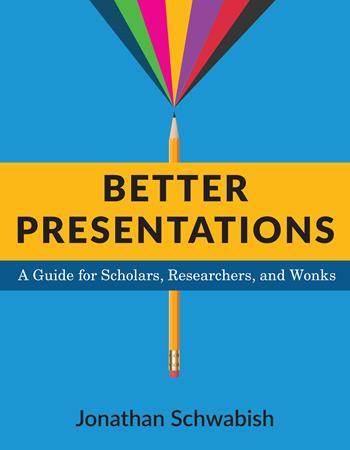Five Ways Researchers Can Improve Their Presentations
“It’s crucial, so I’ll say it once more: A presentation is a fundamentally different form of communication than what you write down and publish in a journal, report, or blog post.” — Jonathan Schwabish
This week, our featured book is Better Presentations: A Guide for Scholars, Researchers, and Wonks, by Jonathan Schwabish. To kick off our feature, we are happy to crosspost an article in which Schwabish lays out five steps that researchers can take to give better presentations. This post was originally published on the Urban Institute’s blog, Urban Wire, on November 17, 2016.
Don’t forget to enter our book giveaway for a chance to win a free copy of Better Presentations!
Five Ways Researchers Can Improve Their Presentations
By Jonathan Schwabish
Too many researchers prepare presentations by simply converting a report into slides. Text becomes bullet points; tables and figures get copied and pasted. But presenting is a fundamentally different form of communication than writing. When we treat our presentation and paper identically, we miss this important distinction and the opportunity to share our work as effectively as possible.
In my new book, Better Presentations: A Guide for Scholars, Researchers, and Wonks, I explain how to create, design, and deliver an effective presentation. Here are five tips from the book for giving better presentations.
- Plan and outline. We’re taught in elementary school to construct an outline and develop a structure before writing a book report. Why do we pay attention to outlining and planning when we write but prepare presentations on the fly? Before you present, plan your presentation and recognize that the outline for your presentation may differ from the outline for your report. Construct an engaging hook to draw your audience in from the start, have a path from one section of your talk to another, and craft a closing statement that focuses your audience’s attention on the important message you want them to take away.
- Layer. Most researchers put too much stuff on their slides, from dozens of bullet points to dense, complex graphs. Instead of trying to put all that content on a single slide, break it up using a strategy I call layering. Instead of showing all five of your bullet points on a single slide, use five separate slides (and, preferably, less text on each). Present each point—each goal—on its own. Together, the five slides come back to the original (the one that was forcing your audience to read too much). In this way, you guide your audience through your argument one clear step at a time.
- Design for the back of the room. Because so many presenters put so much on their slides, text tends to get small, and images look blurry. Just because the slides look good to you on your computer screen doesn’t mean that someone 20 feet away will be able to see them. Zoom out in your presentation software to 40 or 50 percent, or walk to the other side of your office. Are the text and images still clear? If not, redesign.
- Tell stories. Stories can help you connect with your audience on an emotional level and will stay with people long after you’re done speaking. Stories about how and why you became interested in your research topic or some data or survey challenges you faced can help motivate your presentation and engage your audience emotionally. Politicians know it’s critical to make personal connections with their audience, but those of us presenting in academic and scientific fields often forget the importance of doing so.
- Practice. One of the most important things you can do to give a great presentation is to practice. If you practice your 15-minute conference presentation four times in an hour, you’ll probably have four times more practice than anyone else at the conference—and it will show. The more you practice, the more familiar you will be with your content, and the less you’ll have to rely on text-heavy slides to remind you what to say. Practicing—or rehearsing—involves standing up, holding your presentation clicker, and speaking aloud. Close your office door, silence your phone, and disengage from e-mail. Practicing is not about memorizing your presentation, it’s about becoming more familiar with how you want to present your content.
It’s crucial, so I’ll say it once more: A presentation is a fundamentally different form of communication than what you write down and publish in a journal, report, or blog post. Bring your audience along on the journey of your presentation, and they’ll remember you and your work and will act on the content you deliver.
Read the original post at the Urban Institute’s Urban Wire blog.




